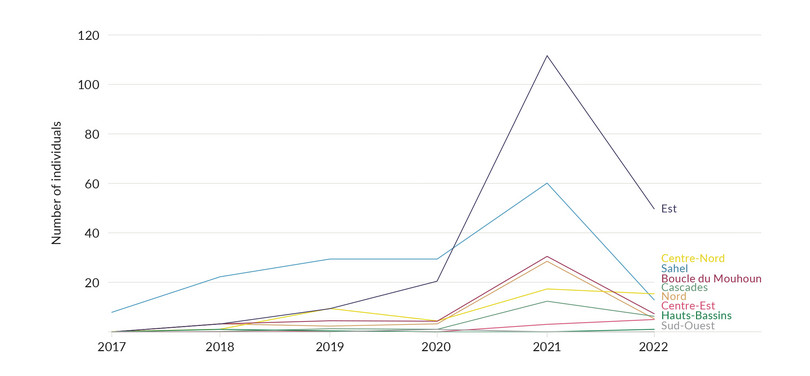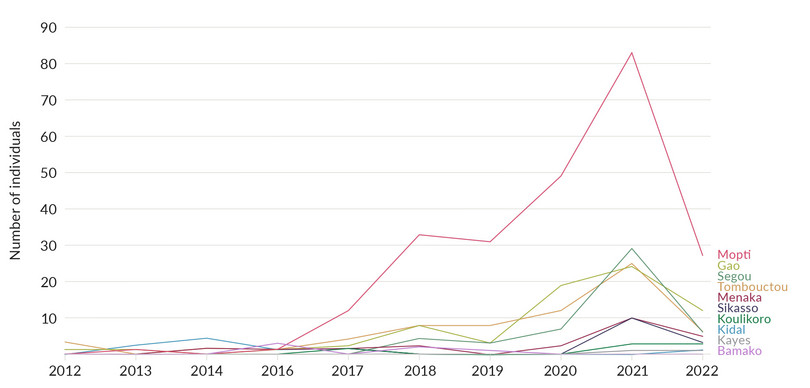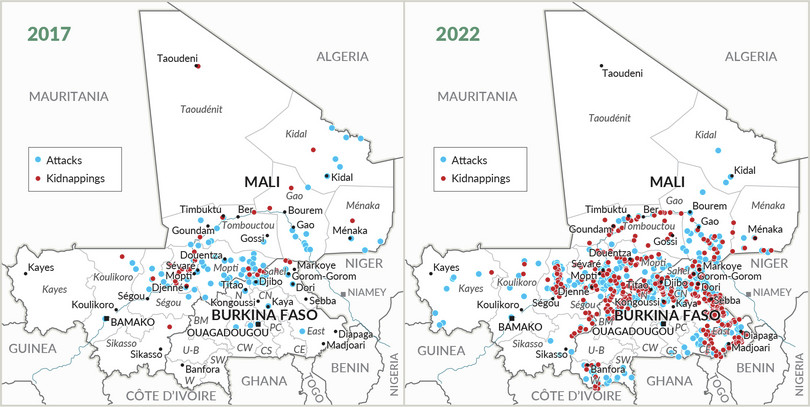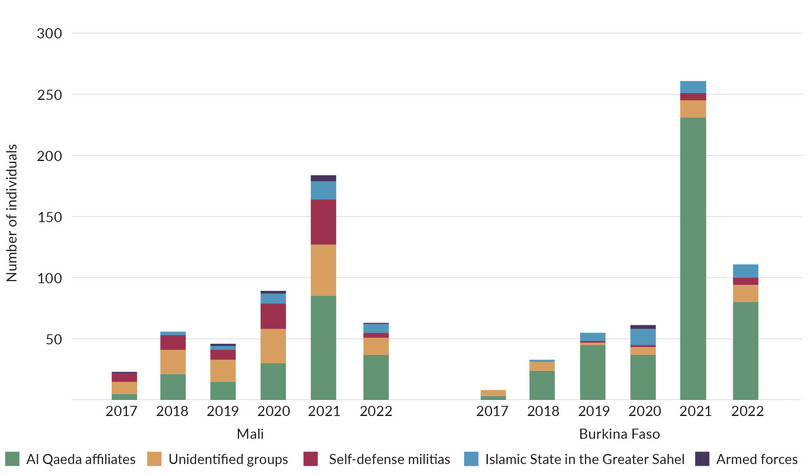The strategic logic of kidnappings in Mali and Burkina Faso.
The international focus on the issue of kidnapping as a business in the Sahel has dropped dramatically, in large part due to a reduction in the number of Western nationals falling victim to it.1 However, the phenomenon has far from disappeared. The kidnapping industry in central Mali and northern Burkina Faso continues to swell, with most victims being locals caught in the crossfire between the numerous armed groups operating in the region.
On 5 May 2022, 31 women were kidnapped in Femaye commune, Djenné cercle, in the central region of Mopti, Mali. According to the Dozo hunters (traditional hunters often carrying out the role of community protectors, operating across central Mali and other countries in West Africa) and government sources, as soon as the hunters heard gunshots, they began a search for the women, leading the jihadists to abandon their kidnap attempt and flee.2 However, according to a source with local knowledge of the incident, the version of events relayed by the Dozo hunters was an attempt to conceal a far less flattering truth.

Figure 7 Number of individuals kidnapped in Burkina Faso, per region, 2017–2022.
NOTE: 2022 data as of 26 May. Regions with no kidnapping incidents since 2017 are not included.
Armed Conflict Location and Event Data
In reality, the jihadist group Jama’at Nasr al-Islam wal Muslimin (JNIM) had kidnapped the women and released them several hours later. They ordered them to go to the nearby town of Djenné, 5 kilometres away, and stay there overnight before returning home. The women then returned to their village on 6 May. No violence was used, no sexual abuse took place and no money was stolen or requested as ransom. Instead, the motive of this kidnapping was to humiliate the Dozo hunters, illustrating to them and the whole community their inability to protect their women.3
This incident, one among the daily reports of kidnappings in conflict-affected areas of Mali and Burkina Faso, underscores the threat that kidnapping poses to communities caught in the crossfire between several armed groups across swathes of both countries. The incident also illustrates some key characteristics of the kidnapping economy in central Mali and Burkina Faso: punishment of enemies, intimidation of communities and recruitment appear to be prominent motivations, while profit (by way of ransom) often appears a secondary driver.
From the early 2000s until around 2012, kidnappings were located mostly in northern Mali, which is where the conflict originated. Westerners were an important – albeit not exclusive – target, and their kidnapping represented the main source of revenue for al-Qaeda in the Islamic Maghreb, so much so that it was called the industrie de l’enlèvement (kidnapping industry).4 As kidnappings of Westerners sharply declined, largely due to the fact that the number of potential victims became more limited as Westerners became more rare in the area, the targeting of locals became the central feature of the kidnapping industry in Mali. Around 97% of the targets of kidnappings in Mali since 2012 have been local citizens.5

Figure 8 Number of individuals kidnapped in Mali, per region, 2012–2022.
NOTE: 2022 data as of 26 May.
Armed Conflict Location and Event Data
The kidnapping economy in Mali and Burkina Faso is swelling:6 in Mali, the number of individuals kidnapped rose eight-fold between 2017 and 2021, from 22 to 184 (the majority of victims across this time period were abducted in the country’s central regions), while in Burkina Faso, kidnappings increased more than 30-fold, from eight in 2017 to 258 in 2021.7 This trend shows no signs of slowing in 2022 – kidnappings in Burkina Faso as of 26 May showed a 10% increase from the same period in 2021.8
The epicentres of the kidnapping economy broadly overlap with the areas most affected by conflict in the two countries.9 As the conflict has geographically expanded – with Burkina Faso replacing Mali as the epicentre – so have the areas most heavily affected by kidnapping.
The new strategic logic of kidnapping in central Mali and Burkina Faso?
Analysis of the targets of kidnapping in central Mali and northern and eastern Burkina Faso, the regions most affected by conflict and where kidnappings are currently concentrated, suggests that abductions operate primarily as a war instrument, wielded for purposes of intimidation, punishment and recruitment, with profit often featuring only as a secondary motivation.
The majority of kidnapping victims are communities caught between various groups fighting to expand their reach, often along ethnic lines, especially in Mali’s central regions.10 Many families of victims do not have the capacity to pay ransom. The Macina Liberation Front (Katibat Macina) in central Mali regularly abducts civilians, including those with a social or religious status within the community; however, often no ransom request is received. Instead, after a couple of days or weeks, the body is found at the entrance of the village.11
In both countries, all parties to the conflict are known to resort to kidnapping, including state actors (see Figure 10). The targets typically vary depending on the primary motivation of the kidnap. In Mali and Burkina Faso, victim typologies suggest three forms of motivation are most common.
First, kidnappings are carried out to punish anyone perceived as the ‘enemy’ because of their leadership position and ability to influence the community, or because they represent the national authorities that armed groups are aiming to eliminate. These include administrative authorities (such as mayors and local law enforcement) and traditional authorities (religious leaders and village heads). Targeting these groups has a clear goal of further weakening central authorities and disrupting traditional norms to prevent pushbacks for their own model. In addition to authority figures, however, anyone who is deemed to be a traitor or a collaborator may also be targeted. For example, local staff at NGOs operating in conflict hotspots in Mali and Burkina Faso are arrested and abducted by armed groups on a weekly basis.12 In such areas, according to an interviewee involved in the security of NGOs, ‘being seen talking to the enemy is enough to be kidnapped.’13

Figure 9 Violent incidents in Mali and Burkina Faso, 2017 versus 2022.
NOTE: 2022 data as of 26 May.
Armed Conflict Location and Event Data
Secondly, and linked to the first typology of kidnappings, abductions are used by armed groups as an instrument to terrorize and intimidate local populations to deter anyone from opposing them, or from joining or even sympathizing with another group. The primary targets of such kidnappings are the local population living in areas under the influence or control of armed groups. The 5 May kidnapping of 31 women is a prime example of this, as the motivation was to intimidate the community living under Dozo hunters’ ‘protection’. The JNIM has now threatened this protection, showing that they can reach into territory typically under Dozo influence. Similarly, kidnappings are leveraged as a form of enforcing governance rules imposed by armed groups. For example, in central Mali, there have been cases where the village chief, or any other villager, refuses to pay the zakat on livestock or on their harvest and, as a regional expert said, ‘if you refuse, they will kidnap you and release you when money has been paid.’14
Thirdly, forced recruitment by armed groups from local populations can also be understood as a form of kidnapping (notwithstanding the fact that such abductions can also constitute human trafficking). Local communities are asked to contribute to the war effort and children are abducted to join the ranks of armed groups. Following the Moura incident in late March, in which the Malian armed forces and ‘associated foreign soldiers’ allegedly executed an estimated 300 civilians in a purported counter-terrorism operation,15 Katibat Macina went house by house in several villages of Djenné cercle, telling people that they had to contribute to the war effort.16
When one father refused to hand over his son, they killed one of his nephews. Upon the return of the Katibat Macina militants several days later, the father had little choice but to hand over one of his sons.17 In the same operation, the Katibat Macina also abducted several people, including officials, who were accused of having given names of their members to the security forces before the operation.18
Kidnappings as a money-making venture?
Although profit does not always appear to be the driving force behind the kidnapping economy of central Mali and Burkina Faso, armed groups do ask for ransom in many cases. For example, the Dogon militia Dan Na Ambassagou, the main self-defence militia in central Mali, kidnapped six people in Bandiagara on 22 May 2022 and allegedly demanded ransom.19 Since 2017, kidnapping for ransom has been an important source of revenue for the militia, alongside cattle theft and protection rackets.20 The ransom paid for each individual kidnapping is significantly lower than what armed groups would receive for a Western national, but, according to an expert on local kidnappings, ‘the scale is very different, so eventually that amounts to a substantial sum.’21 Most sources report that ransom prices vary from FCFA1 million to FCFA5 million and can go higher for a high-level state representative or member of the armed forces.

Figure 10 Number of individuals kidnapped in Mali and Burkina Faso, per perpetrator, 2017–2022.
NOTE: 2022 data as of 26 May.
Armed Conflict Location and Event Data
It is clear that individuals known to have a degree of wealth are also being targeted; this appears to be particularly prominent in cases where kidnappings are linked to other illicit economies, such as cattle rustling, a prominent illicit market in central Mali, as explored in the first article of this issue.22 One regional expert noted that ‘in areas where there is a lot of cattle rustling, there are also a lot of kidnappings, and the two dynamics reinforce each other.’23 When armed groups steal the cattle, they often kidnap the herder or the owner of the cattle, because they know that ‘the owner of the cattle, or his family, has money and will pay extra to get him back.’24
In the main cities of northern Mali, and especially in Gao, the dynamics are slightly different, with profit more clearly a shaping motivation. The contrast underscores the differences in the nature of the kidnapping industry between central Mali, currently the epicentre of conflict, and northern Mali, where violence is currently lower. In Gao, and other major urban hubs in the north of Mali, so-called ‘bandits’ are strategic in their targets – they typically abduct businessmen (opérateurs économiques), hotel managers and members of rich families, as well as high-level officials and their family members. Armed groups target a family that they know has money and pay bandits (known as petites mains – small hands) to observe and gather intelligence on their whereabouts and their habits. According to an aid worker with knowledge of incidents in Gao, ‘if they can get the head of the family, they will. Otherwise, they will try to take another member of the family, like one daughter.’25 On 12 May 2022, for example, the daughter of an important businessman in Gao was abducted and subsequently released following a ransom payment.
While the kidnapping of foreign nationals generally has a limited impact on local stakeholders and communities, the kidnapping of local residents multiplies the harms experienced by communities. Kidnapping for ransom continues to be a source of some funding for jihadist groups; however, perhaps even more important in the context of the security crisis in the region is the role that the illicit economy plays in damaging local communities, and constituting a tool in armed-group governance.
The kidnapping of individuals with strategic leadership roles heavily undermines both local and national security institutions, as figures that are traditionally or administratively responsible for maintaining social, religious and legal norms are directly targeted. Moreover, it also drives bottom-up grievances towards the state, as the communities that suffer from violence (in the form of threats, abduction and murder) perpetrated by all sides of conflict parties do not feel protected by the national authorities. This, in turn, allows for greater entrenchment of both non-state armed groups and organized criminal groups in the region, further eroding the already weak local governance.26 To compound the issue, data on the phenomenon is scarce, inhibiting a fuller grasp of the scale of the problem for the purpose of informing policy responses.
Notes
-
Five Westerners were kidnapped in a recent surge in Mali and Burkina Faso in April and May. It is clear that armed groups in the region have not renounced kidnapping for ransom as a source of financing. ↩
-
Issa Diallo, Djenné: 32 femmes libérées quelques heures après leur enlèvement par des djihadistes, Mali-Online, 11 May 2022, https://mali-online.net/djenne-32-femmes-liberees-quelques-heures-apres-leur-enlevement-par-des-djihadistes. ↩
-
Interview with an expert having local knowledge of the incident, 17 May 2022. ↩
-
Between 2003 and 2010, at least 77 Westerners were kidnapped in the Sahel (Mali, Niger, Algeria and Mauritania), whereas in the 2015–2022 period, approximately 17 were abducted, including nine in Burkina Faso. ↩
-
Ornella Moderan, Jose Luengo Cabrera and Boubacar Diallo, Abductions: the hidden face of Mali’s crisis, Institute for Security Studies, 8 September 2021, https://issafrica.org/iss-today/abductions-the-hidden-face-of-malis-crisis. ↩
-
Armed Conflict Location & Event Data Project (ACLED) data: 1 315 events in 2021, a twofold increase from 2020. In 2021, 2 354 fatalities, exceeding that of Mali for the second time in the last three years. See https://acleddata.com/dashboard/#/dashboard. See also Mucahid Durmaz, How Burkina Faso became the epicentre of conflict in the Sahel, Al Jazeera, 11 March 2022, https://www.aljazeera.com/features/2022/3/11/how-burkina-faso-became-the-new-epicentre-of-sahelian. ↩
-
Armed Conflict Location & Event Data Project (ACLED), https://acleddata.com/dashboard/#/dashboard. ↩
-
Some 101 kidnappings were recorded in Burkina Faso between 1 January and 26 May 2022. ↩
-
In Mali, the areas most affected by violence are in the central regions of Mopti and Ségou, including primarily the Bandiagara, Bankass, Djenné, Koro, Mopti and Ségou districts. The north of the country also sees regular upticks in violence, as seen since early March 2022, especially in Gao and Ménaka regions, along the border with Niger. ISGS and MSA-D/Gatia have been fighting in Ménaka and Gao regions since early March. At least 264 civilians have been killed and 23 000 displaced. See RFI, Mali: la détresse des habitants de la région de Ménaka, 31 May 2022, https://www.rfi.fr/fr/afrique/20220531-mali-la-détresse-des-habitants-de-la-région-de-ménaka. In Burkina Faso, which has replaced Mali as the epicentre of the conflict, the level of violence has exploded in the past three years. Fatalities increased from 117 in 2017 to more than 2 354 in 2021, exceeding the number of fatalities recorded in Mali. In Burkina Faso, the most affected regions are located in the north and east of the country, with the Sahel, Nord, Centre-Nord, Boucle du Mouhoun and Est regions being the most affected. ↩
-
International Federation for Human Rights, Dans le centre du Mali, les populations prises au piège du terrorisme et contre-terrorisme, November 2018, https://www.fidh.org/IMG/pdf/fidh_centre_du_mali_les_populations_prises_au_pie_ge_du_terrorisme_et_contre_terrorisme.pdf. ↩
-
Ibid. ↩
-
Interview with a source involved in security of NGOs in Mali and Burkina Faso, 23 May 2022. ↩
-
Ibid. ↩
-
Interview with a Malian expert on central Mali, 19 May 2022. ↩
-
Human Rights Watch, Mali: Massacre by Army, Foreign Soldiers, 5 April 2022, https://www.hrw.org/news/2022/04/05/mali-massacre-army-foreign-soldiers. ↩
-
Interview with a Malian journalist in Bamako, 23 May 2022. ↩
-
Ibid. ↩
-
Ibid. ↩
-
Confidential security briefing from UN sources, 25 May. ↩
-
Interview with an expert on self-defence militias in central Mali, 28 May 2022. ↩
-
Interview with an expert on kidnappings of locals in Mali and Burkina Faso, 17 May 2022. ↩
-
The relationship between kidnap-for-ransom and cattle rustling is also borne out by the findings of the GI-TOC’s illicit-hub mapping initiative (forthcoming), as part of the project titled ‘Promoting Stabilization Through Crime Sensitive Interventions in West Africa’, funded by the German Ministry of Foreign Affairs. ↩
-
Interview with a Malian expert on central Mali, 19 May 2022. ↩
-
Ibid. ↩
-
Interview with non-governmental organization representatives active in Gao, 21 May. ↩
-
Mark Micallef, et al., After the Storm: Organized crime across the Sahel-Sahara following upheaval in Libya and Mali, 2019, https://globalinitiative.net/wp-content/uploads/2019/11/After_the_storm_GI-TOC.pdf. ↩
